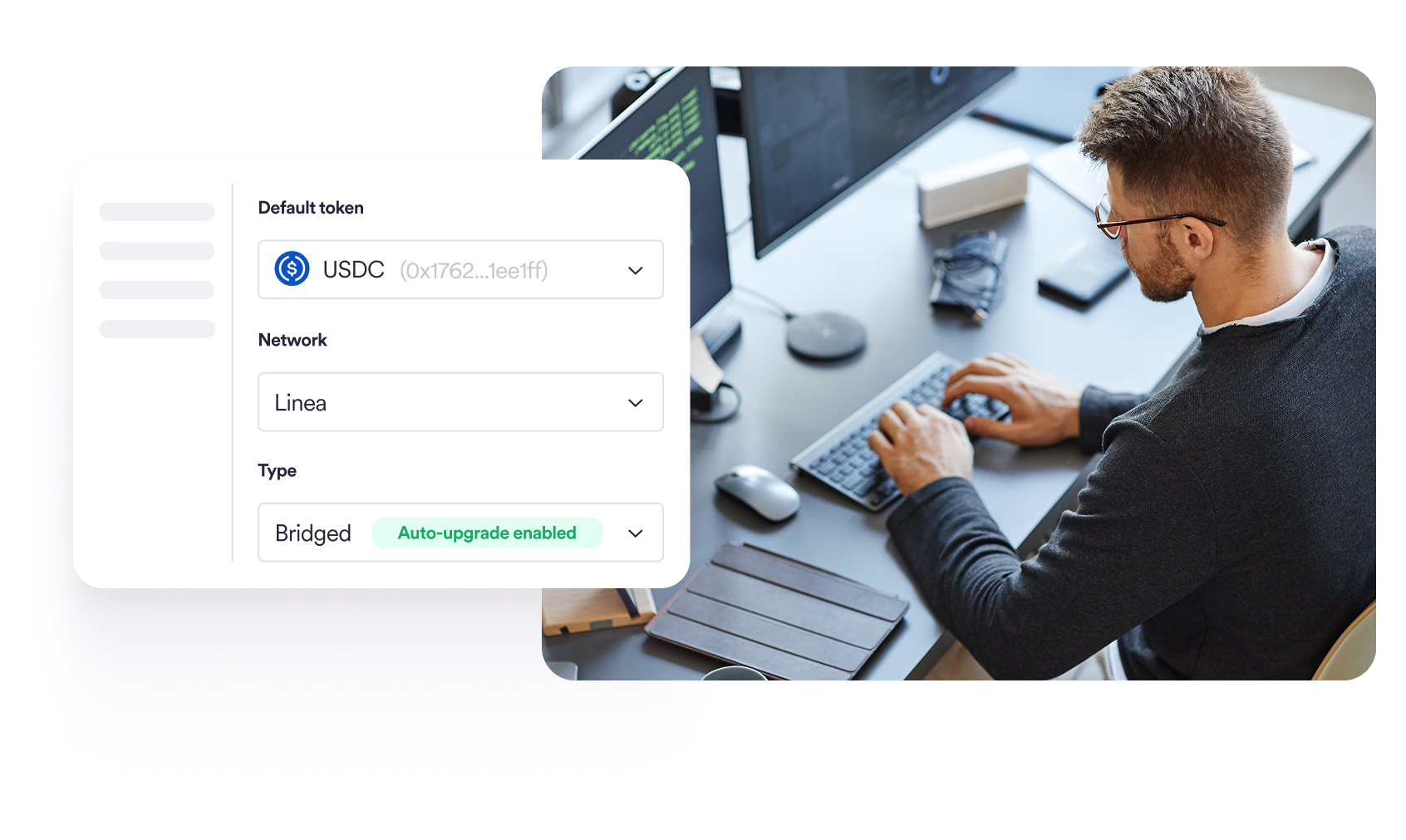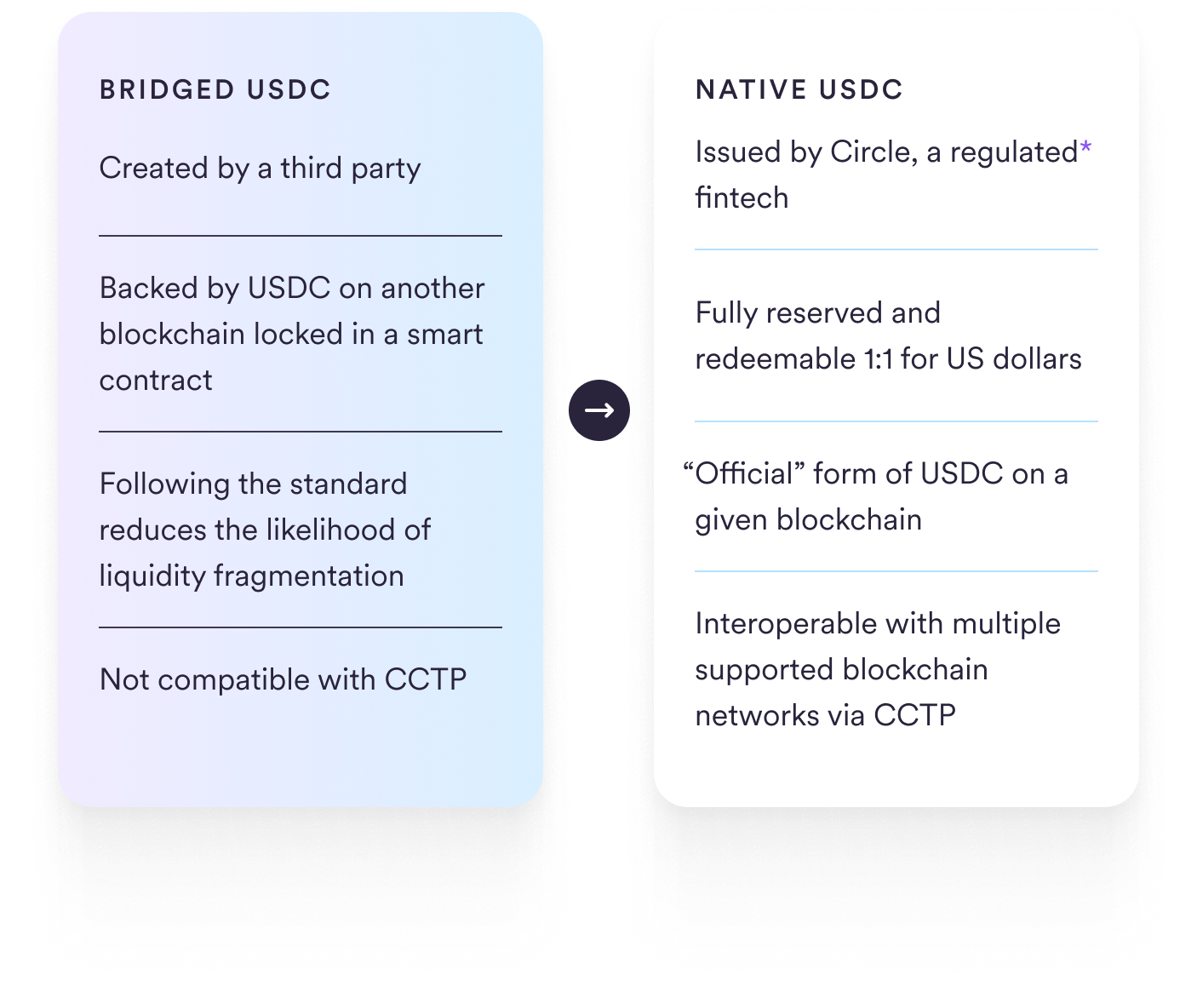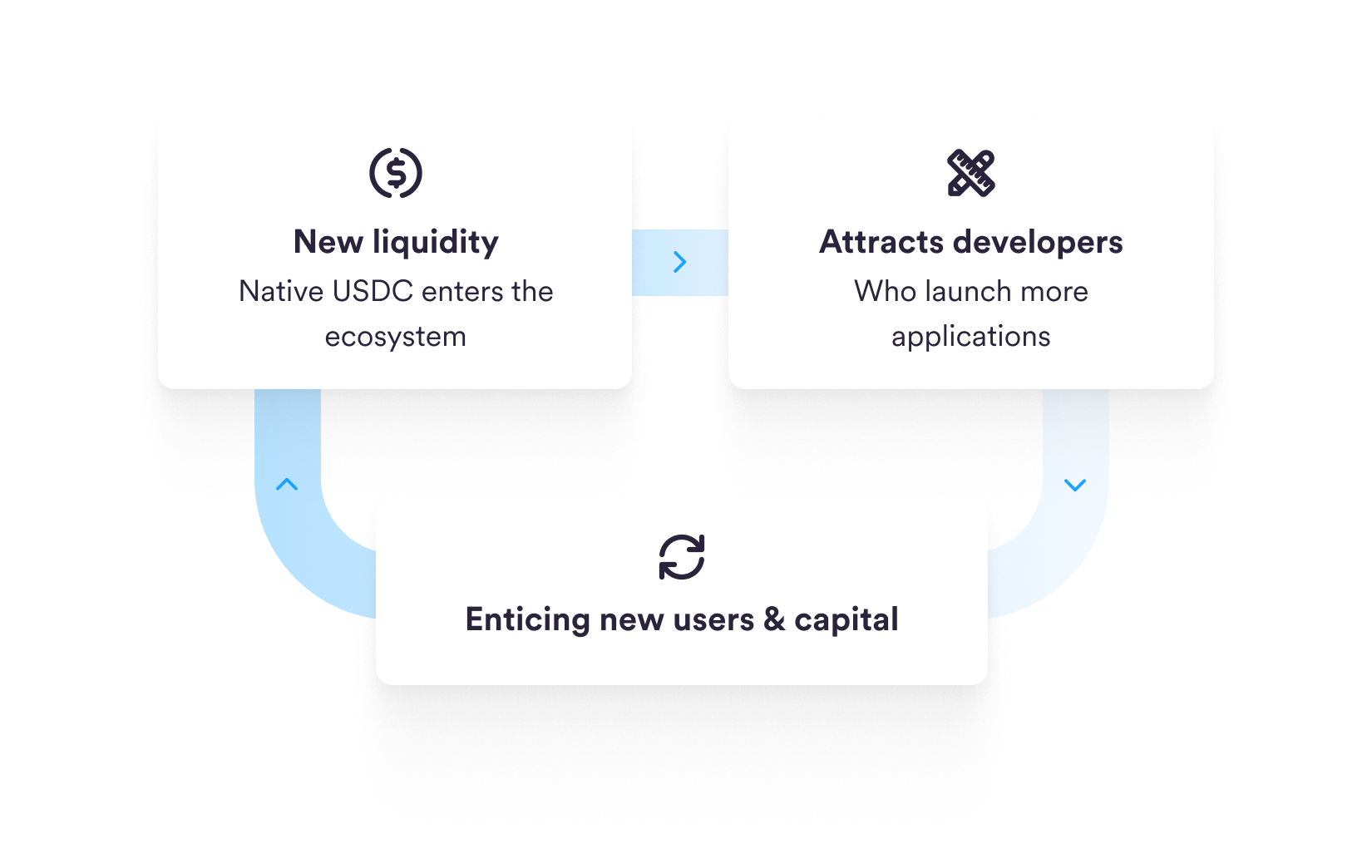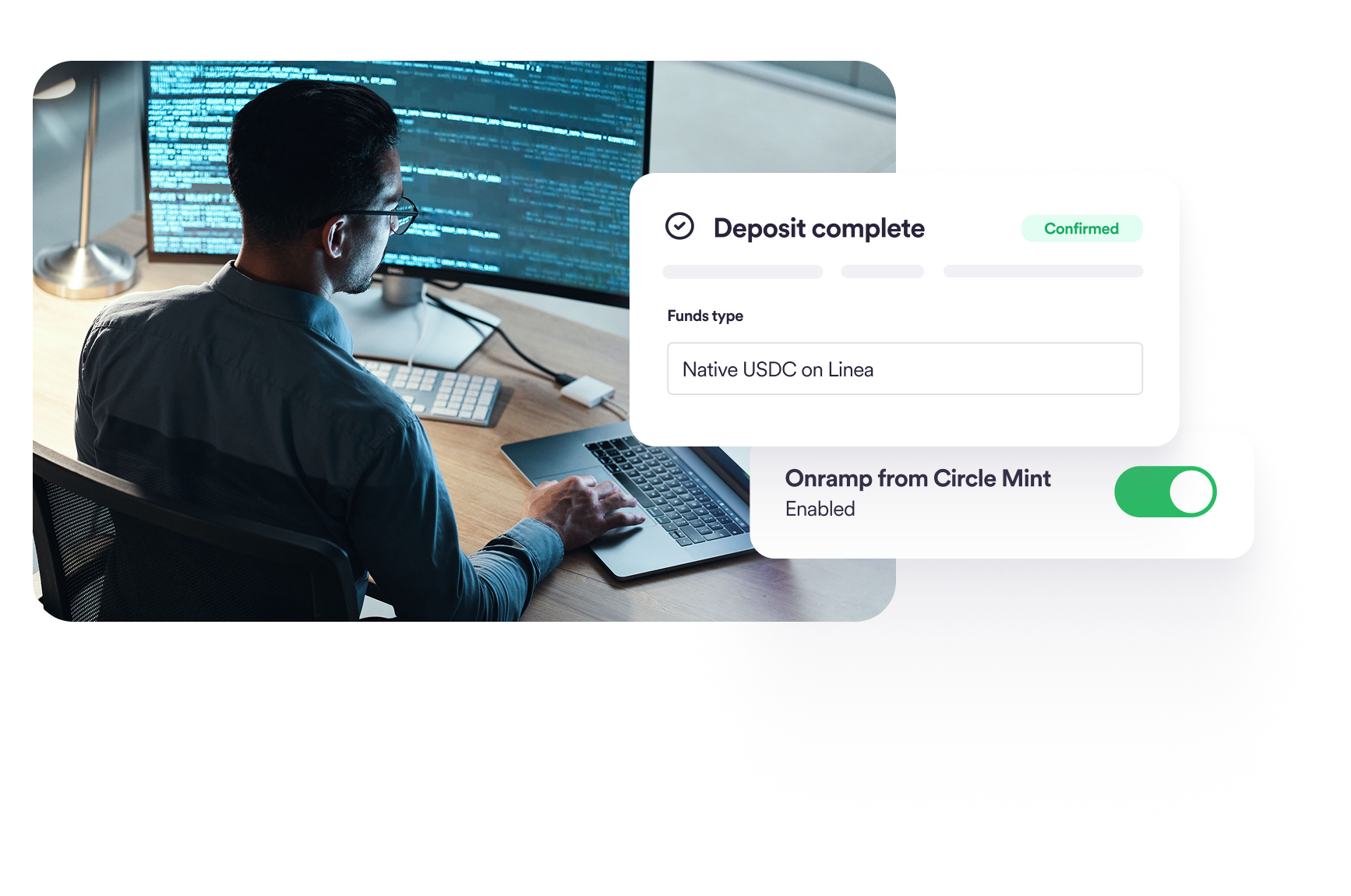
Unlocking native USDC: Linea’s seamless upgrade from Bridged USDC Standard
It was always our goal to upgrade from Bridged USDC Standard to native USDC but there was always some concern in the back of our minds because it had never been done before. That all washed away the instant Circle executed the upgrade. It went flawlessly.”

Bootstrapping onchain development with Bridged USDC Standard
Linea, the zkEVM Layer‑2 built by Consensys, scaled rapidly in its first year, at peak reaching over $1 billion in total value locked across more than 200 applications. From day one that growth was underpinned by USDC.e, a bridged form of USDC aligned to Circle’s Bridged USDC Standard. Bridged USDC Standard enabled Linea to deploy a bridged USDC token contract with optionality for Circle to seamlessly upgrade to native USDC in the future.* Furthermore, it gave developers a single form of bridged USDC for the ecosystem that they could build around to avoid liquidity fragmentation.

Although Bridged USDC Standard helped Linea bootstrap activity on its network, Linea’s leadership always viewed it as a stepping‑stone. For ecosystems courting institutional use cases, bridged USDC can introduce certain limitations: treasury teams cannot mint or redeem directly with Circle and some regulated entities insist on the direct, dollar‑backed guarantees that only native issuance provides. As Linea’s ambitions expanded, those nuances began to matter – with ripple effects that spread to other ecosystem participants.
Businesses and developers faced a different but related challenge. Because institutional liquidity remained shallow, the economic flywheel that normally powers ecosystem growth spun only slowly. Limited capital kept trading spreads wider and borrowing rates somewhat higher than on ecosystems with native USDC. In that environment some developers hesitated to invest engineering effort, unsure that users would arrive in sufficient numbers to justify the work. The absence of native USDC therefore suppressed the launch of new applications, which in turn limited reasons for users to transfer funds to Linea. The flywheel never stalled completely—Bridged USDC Standard at least guaranteed a single canonical stablecoin contract—but the spin was sluggish enough to cap adoption.
Everyday users felt the downstream effects. Liquidity constraints sometimes translated into visible slippage on decentralized exchanges, while major fiat on/offramps did not support direct deposits or withdrawals of the bridged token. Collectively, those frictions made Linea less attractive as a settlement layer for ordinary payments, savings or onchain commerce.
Unlocking growth with native USDC
Recognizing that native USDC could resolve these intertwined problems, Circle and Linea agreed to execute the industry’s first in‑place bridged‑to‑native upgrade. The transition from bridged to native USDC was meticulously engineered to guarantee continuity while eliminating the need for liquidity migration, providing a seamless transition that preserved user trust and enhanced the functional utility of USDC within the Linea ecosystem.

On March 16, 2025 Linea paused its canonical bridge, allowing outstanding transactions to finalize. Ownership of the Bridged USDC Standard contract then transferred to Circle who performed the upgrade. As a result, every balance of USDC.e automatically became native USDC. No developer, user, wallet, exchange or smart contract had to migrate, swap or rewrite code. With the bridged contract upgraded, Circle immediately deployed CCTP V2 on Linea, unifying liquidity and simplifying user experience by enabling USDC to flow natively between Linea and supported blockchains at faster-than-finality speeds.
Upgrading from Bridged USDC Standard to native USDC marks a turning point for our network. Native, fully redeemable USDC removes the final barrier for institutional capital, and we can already see new market-makers deepening liquidity across our DeFi rails within days of launch.”
The benefits of that sequence were immediate and far‑reaching. Qualified institutions gained Circle Mint support for Linea and could mint or redeem USDC directly from Circle without touching a third-party exchange or bridge. Because CCTP V2 enables faster-than-finality transfers, treasurers now move liquidity across Linea and supported blockchains in near real time, allowing market‑makers to quote tighter spreads and traders to arbitrage opportunities. Counterparty risk diminished, operational complexity collapsed and compliance teams collectively breathed a sigh of relief at the prospect of working directly with native USDC, the world’s largest regulated1 stablecoin.
For developers, the upgrade preserved all four pillars of Bridged USDC Standard – permissionless and equitable deployment, a standardized extensible interface, independent security audits and seamless upgradeability – while inviting the crucial ingredient of abundant, regulated1 liquidity. DeFi app developers did not need to refactor a single line of code, yet they woke up to deeper pools, lower price impact and the knowledge that Circle Mint onramps could feed capital directly into their protocols. The result is a virtuous cycle: richer liquidity attracts more developers, who launch more applications, which in turn entice new users and capital.

End users experienced the most tangible improvements. Decentralized exchange trades clear at tighter prices and leading onramps now list native USDC on Linea alongside their other supported chains. The process of sending, spending, saving or trading in digital dollars on Linea now feels comparable to the experience on chains where native USDC has long been present.
Onchain data confirm the magnitude of the shift. More than $21 million in circulating USDC.e converted to native USDC upon the upgrade, with no reported user issues. Simultaneously, CCTP V2 on Linea was activated. Linea apps have begun to share qualitative feedback, noting that the upgrade paired with CCTP V2 has meaningfully increased USDC TVL on their platforms and that users required no education beyond the simple announcement that USDC on Linea is now native.
Customers can fund their wallets with native USDC on Linea directly from globally accessible, reputable platforms. There are no bridge pop-ups, no scary wait times – just a stable digital dollar that behaves exactly as you’d expect."
A definitive model for future blockchain transitions
The Linea bridged-to-native upgrade offers a repeatable blueprint for any EVM blockchain. Any network can adopt Bridged USDC Standard* to cultivate an active developer community with meaningful USDC.e TVL, and later on enter into a commercial arrangement with Circle to execute the same seamless upgrade without fragmenting liquidity or forcing users to migrate. In that light, Bridged USDC Standard should be understood not as a lesser substitute for native USDC but as a forward‑compatible staging ground that preserves the option to graduate to full native status of the regulated1, fully redeemable form of USDC that institutions and users ultimately demand. The result is an increasingly interconnected, capital‑efficient onchain economy in which native USDC operates as the common denominator for internet finance.

1USDC is issued by regulated affiliates of Circle. A list of Circle’s regulatory authorizations can be found here.
* (1.) Bridged USDC Standard grants Circle the option, but not the obligation, to obtain ownership of the token contract and upgrade to native USDC. Additionally, Bridged USDC Standard must be incorporated prior to deploying a bridged USDC token contract as it cannot be retroactively applied. The requirements provided are for informational purposes only and will apply should Circle choose to upgrade a particular form of bridged USDC to native USDC. These requirements do not constitute an offer to upgrade a particular form of bridged USDC. Circle’s decision to upgrade a particular form of bridged USDC to native USDC may be subject to additional terms and conditions. As noted in Section 8 of the USDC Terms of Use, bridged forms of USDC are subject to certain risks and are not issued by Circle. (2.) The target blockchain will undergo Circle’s internal Blockchain Due Diligence Process. That process involves reviews for both compliance and risk factors, as well as coverage for legal and technology risks, prior to approval. The diligence focuses on crypto and blockchain nuances, and an assessment of the strategic, financial, operational, technology, legal, and regulatory risks that are present. (3.) During the transition from bridged USDC to native USDC, Circle will securely burn the native USDC that was locked in the bridge smart contract on the origin chain (e.g. Ethereum).
Discover how Circle can help your business
Sign up to receive all the latest news and updates from Circle.
















